CHCPRT001: Child Protection Assessment for Early Childhood Education
VerifiedAdded on 2020/02/19
|26
|6074
|158
Homework Assignment
AI Summary
This assignment workbook, designed for Early Childhood Education and Care students, focuses on the unit CHCPRT001: Identify and Respond to Children and Young People at Risk. The workbook includes a student declaration of original work and covers theoretical questions and case studies. Part A delves into ethical decision-making, forms of abuse (psychological, physical, sexual, and physical neglect), and factors increasing risk of harm, such as age, disability, gender, and culture. Part B presents case studies that require students to apply their knowledge of child protection legislation, identify risk indicators, and outline educator responsibilities in situations involving suspected abuse. The assignment emphasizes mandatory reporting, ethical guidelines, and accessing information on child safety. The student's responses demonstrate understanding of key concepts and application of relevant policies. This assignment is a valuable resource for students studying child protection in early childhood settings. This assignment is contributed by a student to be published on the website Desklib. Desklib is a platform which provides all the necessary AI based study tools for students.
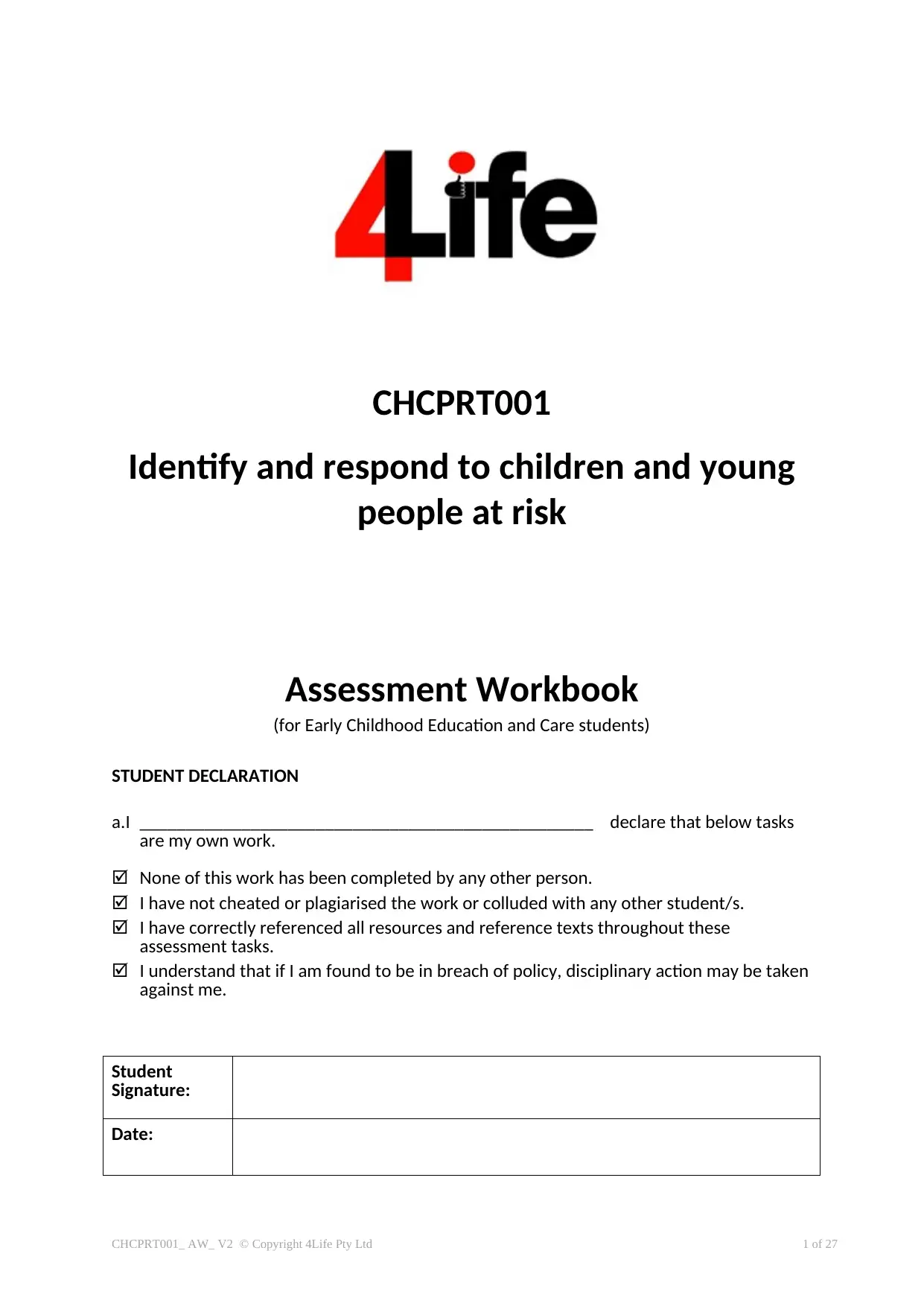
CHCPRT001
Identify and respond to children and young
people at risk
Assessment Workbook
(for Early Childhood Education and Care students)
STUDENT DECLARATION
a.I _________________________________________________ declare that below tasks
are my own work.
þ None of this work has been completed by any other person.
þ I have not cheated or plagiarised the work or colluded with any other student/s.
þ I have correctly referenced all resources and reference texts throughout these
assessment tasks.
þ I understand that if I am found to be in breach of policy, disciplinary action may be taken
against me.
Student
Signature:
Date:
CHCPRT001_ AW_ V2 Copyright 4Life Pty Ltd 1 of 27
Identify and respond to children and young
people at risk
Assessment Workbook
(for Early Childhood Education and Care students)
STUDENT DECLARATION
a.I _________________________________________________ declare that below tasks
are my own work.
þ None of this work has been completed by any other person.
þ I have not cheated or plagiarised the work or colluded with any other student/s.
þ I have correctly referenced all resources and reference texts throughout these
assessment tasks.
þ I understand that if I am found to be in breach of policy, disciplinary action may be taken
against me.
Student
Signature:
Date:
CHCPRT001_ AW_ V2 Copyright 4Life Pty Ltd 1 of 27
Paraphrase This Document
Need a fresh take? Get an instant paraphrase of this document with our AI Paraphraser
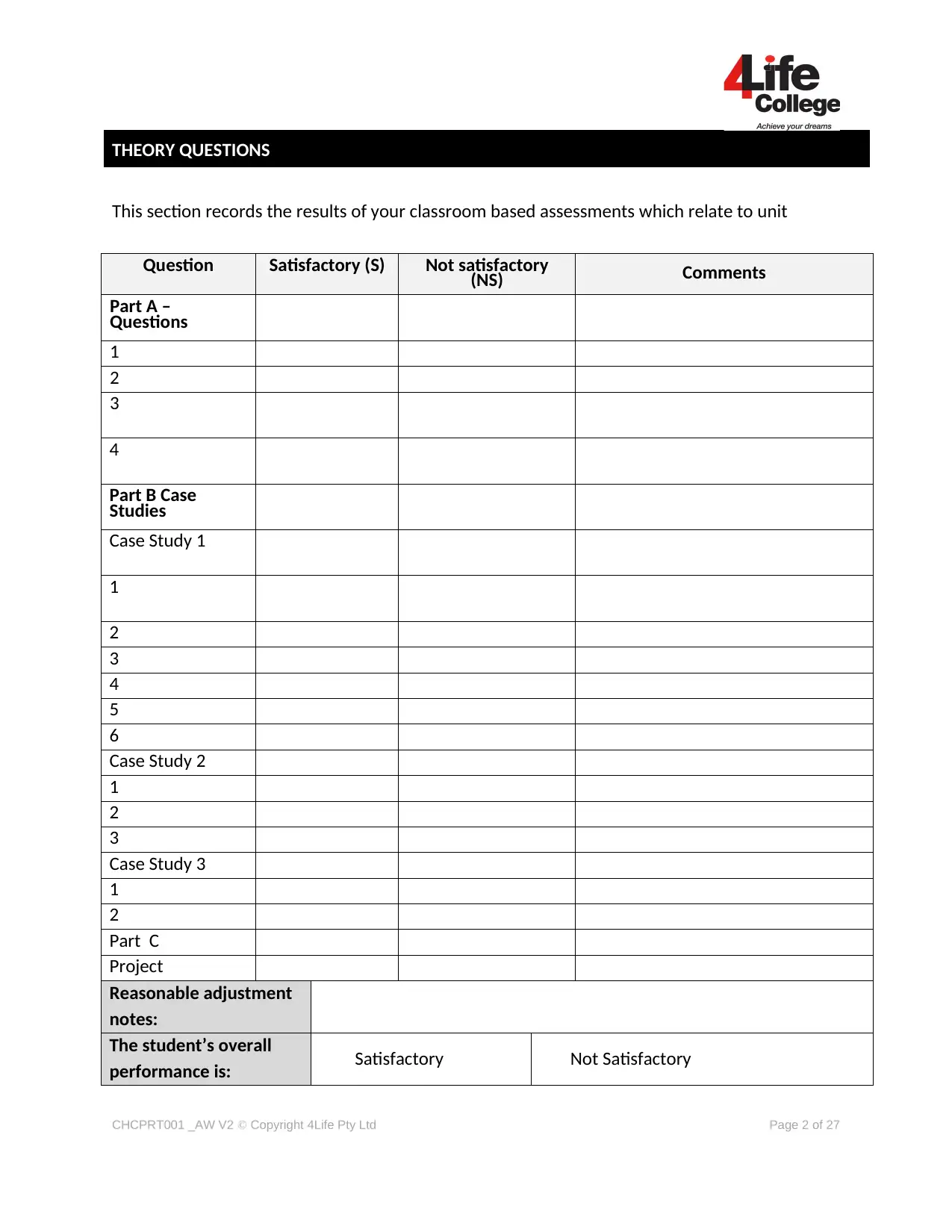
THEORY QUESTIONS
This section records the results of your classroom based assessments which relate to unit
Question Satisfactory (S) Not satisfactory
(NS) Comments
Part A –
Questions
1
2
3
4
Part B Case
Studies
Case Study 1
1
2
3
4
5
6
Case Study 2
1
2
3
Case Study 3
1
2
Part C
Project
Reasonable adjustment
notes:
The student’s overall
performance is: Satisfactory Not Satisfactory
CHCPRT001 _AW V2 Copyright 4Life Pty Ltd Page 2 of 27
This section records the results of your classroom based assessments which relate to unit
Question Satisfactory (S) Not satisfactory
(NS) Comments
Part A –
Questions
1
2
3
4
Part B Case
Studies
Case Study 1
1
2
3
4
5
6
Case Study 2
1
2
3
Case Study 3
1
2
Part C
Project
Reasonable adjustment
notes:
The student’s overall
performance is: Satisfactory Not Satisfactory
CHCPRT001 _AW V2 Copyright 4Life Pty Ltd Page 2 of 27
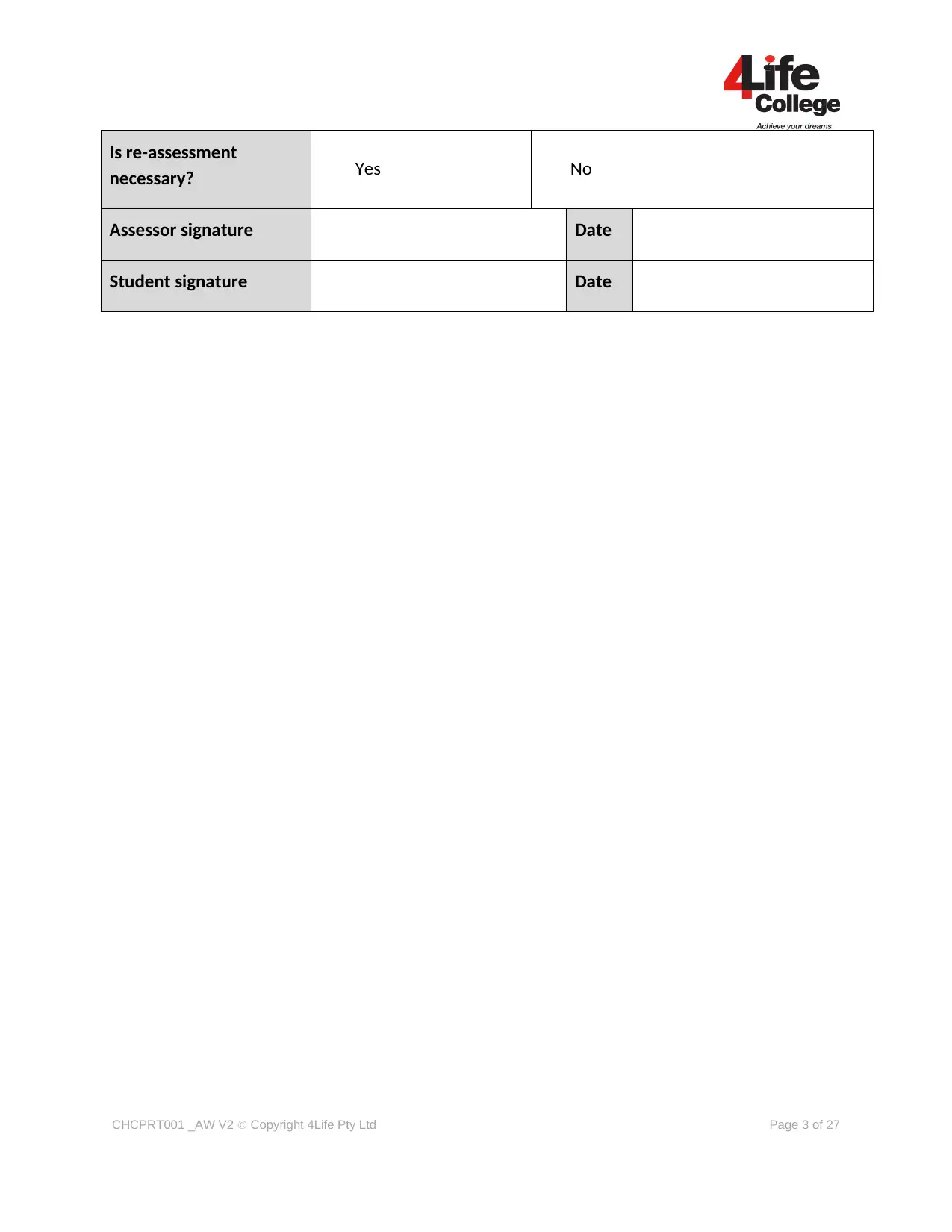
Is re-assessment
necessary? Yes No
Assessor signature Date
Student signature Date
CHCPRT001 _AW V2 Copyright 4Life Pty Ltd Page 3 of 27
necessary? Yes No
Assessor signature Date
Student signature Date
CHCPRT001 _AW V2 Copyright 4Life Pty Ltd Page 3 of 27
⊘ This is a preview!⊘
Do you want full access?
Subscribe today to unlock all pages.

Trusted by 1+ million students worldwide
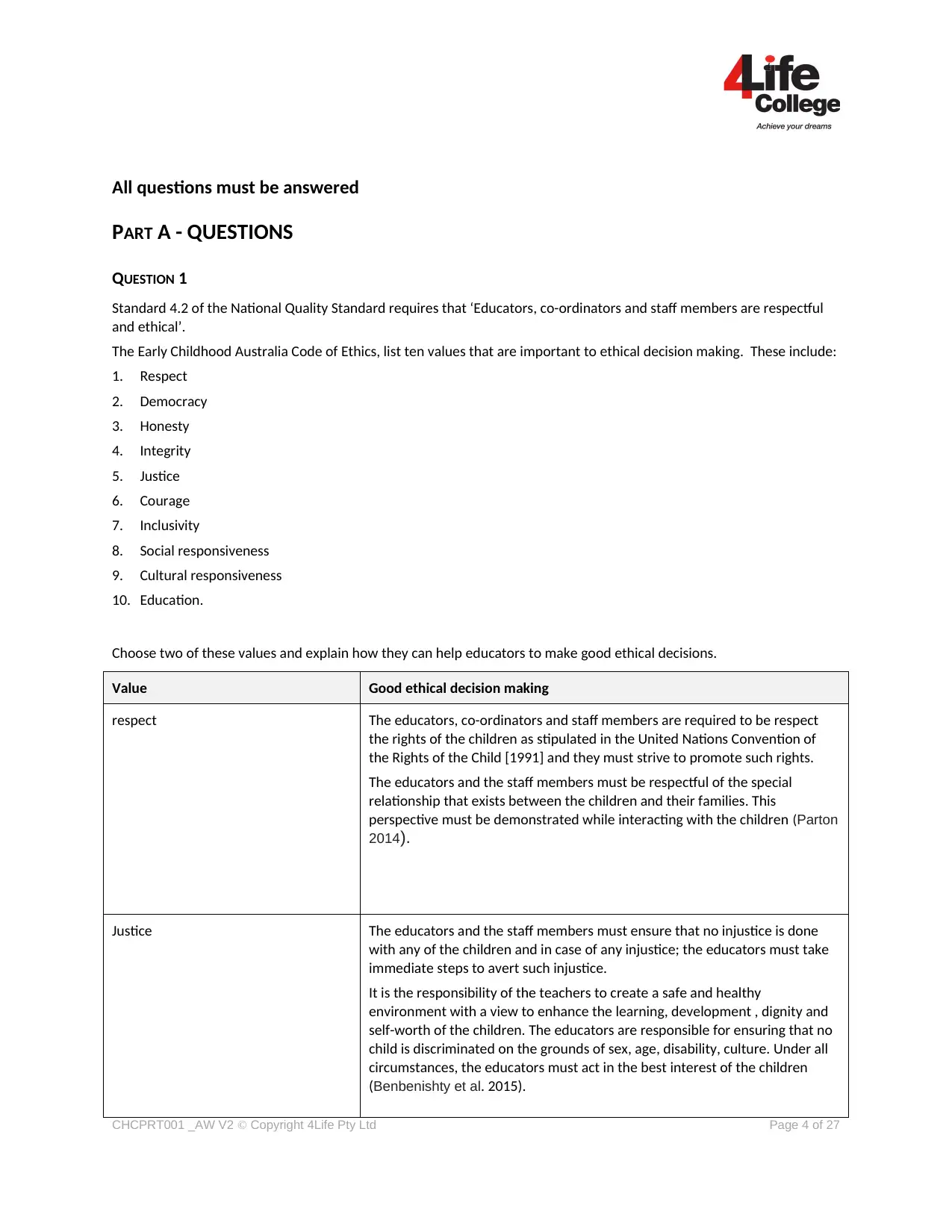
All questions must be answered
PART A - QUESTIONS
QUESTION 1
Standard 4.2 of the National Quality Standard requires that ‘Educators, co-ordinators and staff members are respectful
and ethical’.
The Early Childhood Australia Code of Ethics, list ten values that are important to ethical decision making. These include:
1. Respect
2. Democracy
3. Honesty
4. Integrity
5. Justice
6. Courage
7. Inclusivity
8. Social responsiveness
9. Cultural responsiveness
10. Education.
Choose two of these values and explain how they can help educators to make good ethical decisions.
Value Good ethical decision making
respect The educators, co-ordinators and staff members are required to be respect
the rights of the children as stipulated in the United Nations Convention of
the Rights of the Child [1991] and they must strive to promote such rights.
The educators and the staff members must be respectful of the special
relationship that exists between the children and their families. This
perspective must be demonstrated while interacting with the children (Parton
2014).
Justice The educators and the staff members must ensure that no injustice is done
with any of the children and in case of any injustice; the educators must take
immediate steps to avert such injustice.
It is the responsibility of the teachers to create a safe and healthy
environment with a view to enhance the learning, development , dignity and
self-worth of the children. The educators are responsible for ensuring that no
child is discriminated on the grounds of sex, age, disability, culture. Under all
circumstances, the educators must act in the best interest of the children
(Benbenishty et al. 2015).
CHCPRT001 _AW V2 Copyright 4Life Pty Ltd Page 4 of 27
PART A - QUESTIONS
QUESTION 1
Standard 4.2 of the National Quality Standard requires that ‘Educators, co-ordinators and staff members are respectful
and ethical’.
The Early Childhood Australia Code of Ethics, list ten values that are important to ethical decision making. These include:
1. Respect
2. Democracy
3. Honesty
4. Integrity
5. Justice
6. Courage
7. Inclusivity
8. Social responsiveness
9. Cultural responsiveness
10. Education.
Choose two of these values and explain how they can help educators to make good ethical decisions.
Value Good ethical decision making
respect The educators, co-ordinators and staff members are required to be respect
the rights of the children as stipulated in the United Nations Convention of
the Rights of the Child [1991] and they must strive to promote such rights.
The educators and the staff members must be respectful of the special
relationship that exists between the children and their families. This
perspective must be demonstrated while interacting with the children (Parton
2014).
Justice The educators and the staff members must ensure that no injustice is done
with any of the children and in case of any injustice; the educators must take
immediate steps to avert such injustice.
It is the responsibility of the teachers to create a safe and healthy
environment with a view to enhance the learning, development , dignity and
self-worth of the children. The educators are responsible for ensuring that no
child is discriminated on the grounds of sex, age, disability, culture. Under all
circumstances, the educators must act in the best interest of the children
(Benbenishty et al. 2015).
CHCPRT001 _AW V2 Copyright 4Life Pty Ltd Page 4 of 27
Paraphrase This Document
Need a fresh take? Get an instant paraphrase of this document with our AI Paraphraser
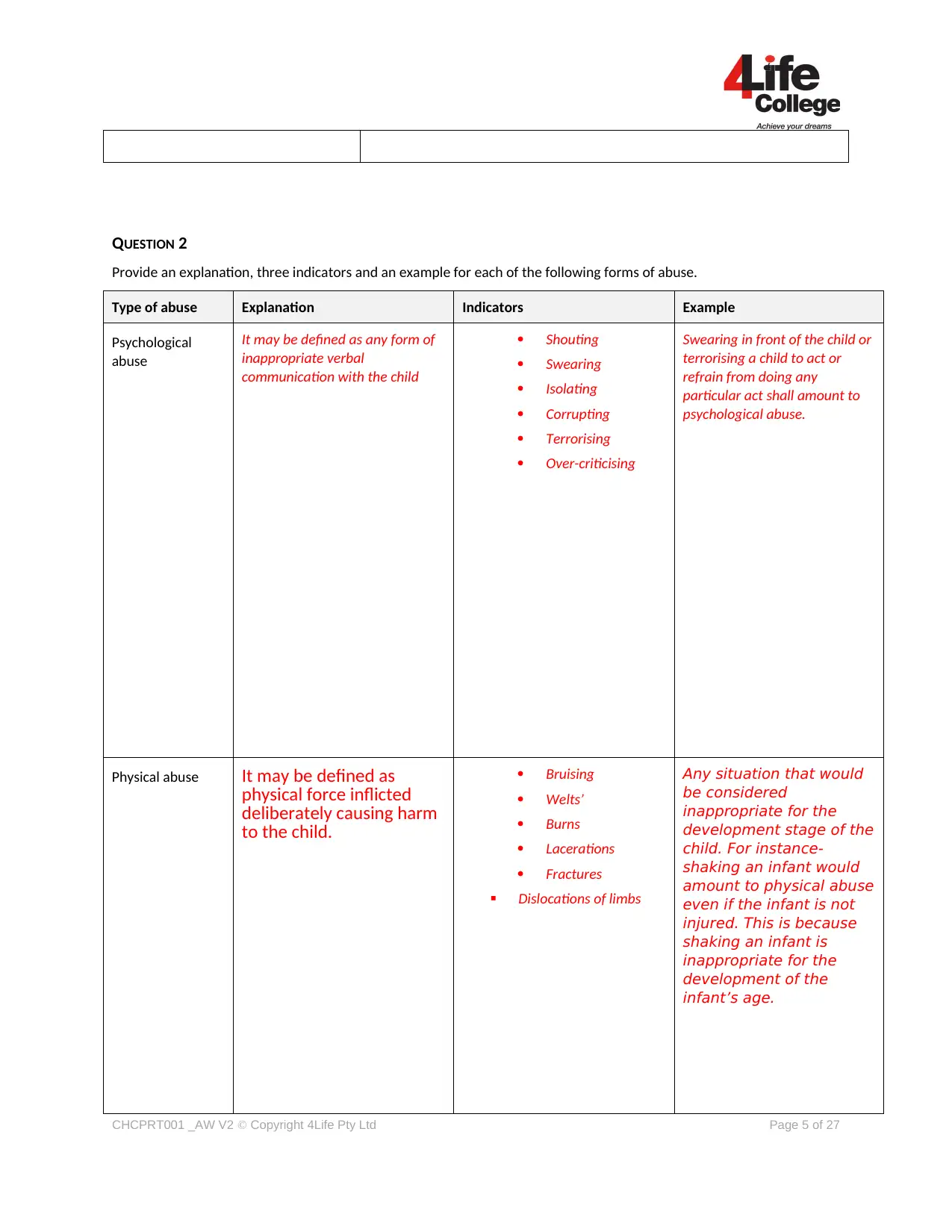
QUESTION 2
Provide an explanation, three indicators and an example for each of the following forms of abuse.
Type of abuse Explanation Indicators Example
Psychological
abuse
It may be defined as any form of
inappropriate verbal
communication with the child
Shouting
Swearing
Isolating
Corrupting
Terrorising
Over-criticising
Swearing in front of the child or
terrorising a child to act or
refrain from doing any
particular act shall amount to
psychological abuse.
Physical abuse It may be defined as
physical force inflicted
deliberately causing harm
to the child.
Bruising
Welts’
Burns
Lacerations
Fractures
Dislocations of limbs
Any situation that would
be considered
inappropriate for the
development stage of the
child. For instance-
shaking an infant would
amount to physical abuse
even if the infant is not
injured. This is because
shaking an infant is
inappropriate for the
development of the
infant’s age.
CHCPRT001 _AW V2 Copyright 4Life Pty Ltd Page 5 of 27
Provide an explanation, three indicators and an example for each of the following forms of abuse.
Type of abuse Explanation Indicators Example
Psychological
abuse
It may be defined as any form of
inappropriate verbal
communication with the child
Shouting
Swearing
Isolating
Corrupting
Terrorising
Over-criticising
Swearing in front of the child or
terrorising a child to act or
refrain from doing any
particular act shall amount to
psychological abuse.
Physical abuse It may be defined as
physical force inflicted
deliberately causing harm
to the child.
Bruising
Welts’
Burns
Lacerations
Fractures
Dislocations of limbs
Any situation that would
be considered
inappropriate for the
development stage of the
child. For instance-
shaking an infant would
amount to physical abuse
even if the infant is not
injured. This is because
shaking an infant is
inappropriate for the
development of the
infant’s age.
CHCPRT001 _AW V2 Copyright 4Life Pty Ltd Page 5 of 27
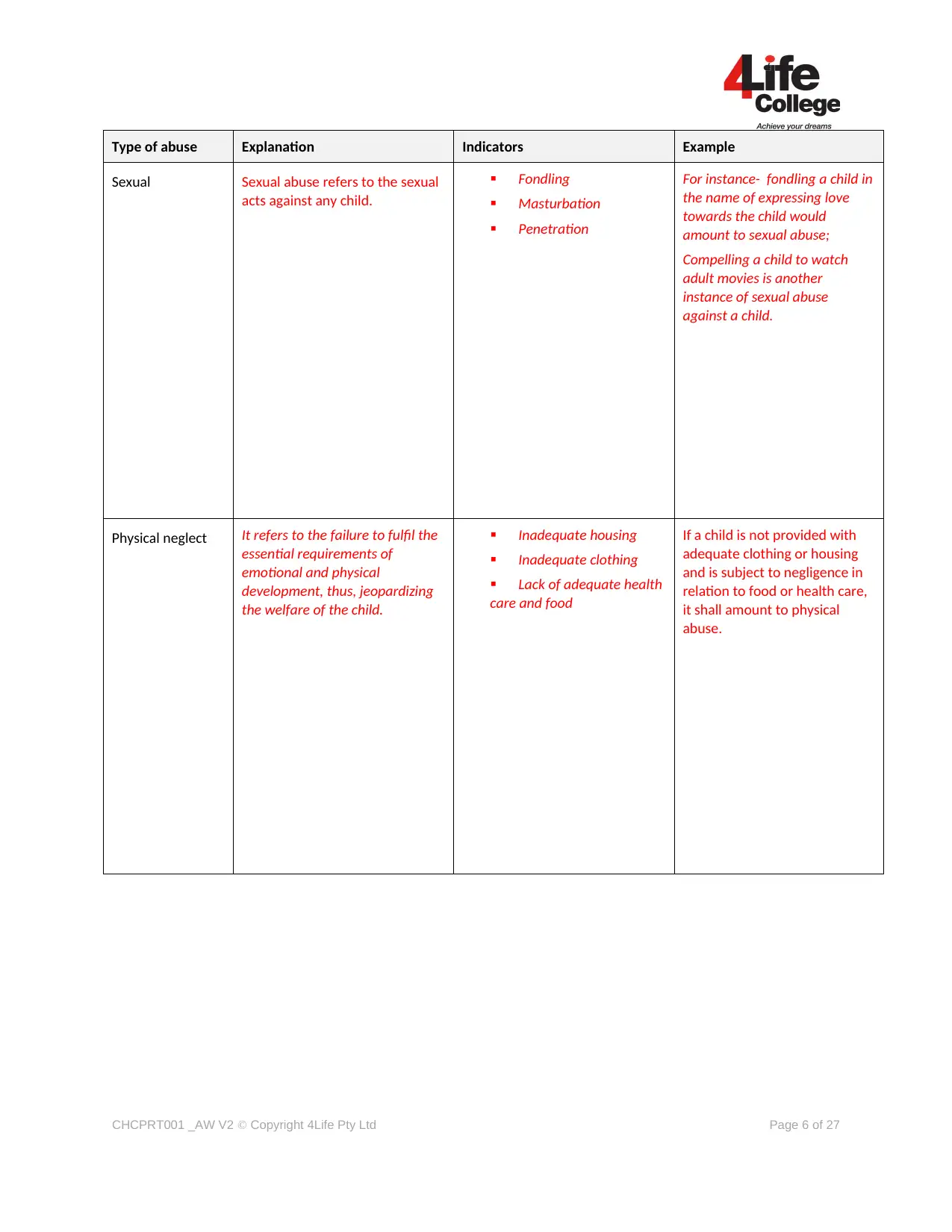
Type of abuse Explanation Indicators Example
Sexual Sexual abuse refers to the sexual
acts against any child.
Fondling
Masturbation
Penetration
For instance- fondling a child in
the name of expressing love
towards the child would
amount to sexual abuse;
Compelling a child to watch
adult movies is another
instance of sexual abuse
against a child.
Physical neglect It refers to the failure to fulfil the
essential requirements of
emotional and physical
development, thus, jeopardizing
the welfare of the child.
Inadequate housing
Inadequate clothing
Lack of adequate health
care and food
If a child is not provided with
adequate clothing or housing
and is subject to negligence in
relation to food or health care,
it shall amount to physical
abuse.
CHCPRT001 _AW V2 Copyright 4Life Pty Ltd Page 6 of 27
Sexual Sexual abuse refers to the sexual
acts against any child.
Fondling
Masturbation
Penetration
For instance- fondling a child in
the name of expressing love
towards the child would
amount to sexual abuse;
Compelling a child to watch
adult movies is another
instance of sexual abuse
against a child.
Physical neglect It refers to the failure to fulfil the
essential requirements of
emotional and physical
development, thus, jeopardizing
the welfare of the child.
Inadequate housing
Inadequate clothing
Lack of adequate health
care and food
If a child is not provided with
adequate clothing or housing
and is subject to negligence in
relation to food or health care,
it shall amount to physical
abuse.
CHCPRT001 _AW V2 Copyright 4Life Pty Ltd Page 6 of 27
⊘ This is a preview!⊘
Do you want full access?
Subscribe today to unlock all pages.

Trusted by 1+ million students worldwide
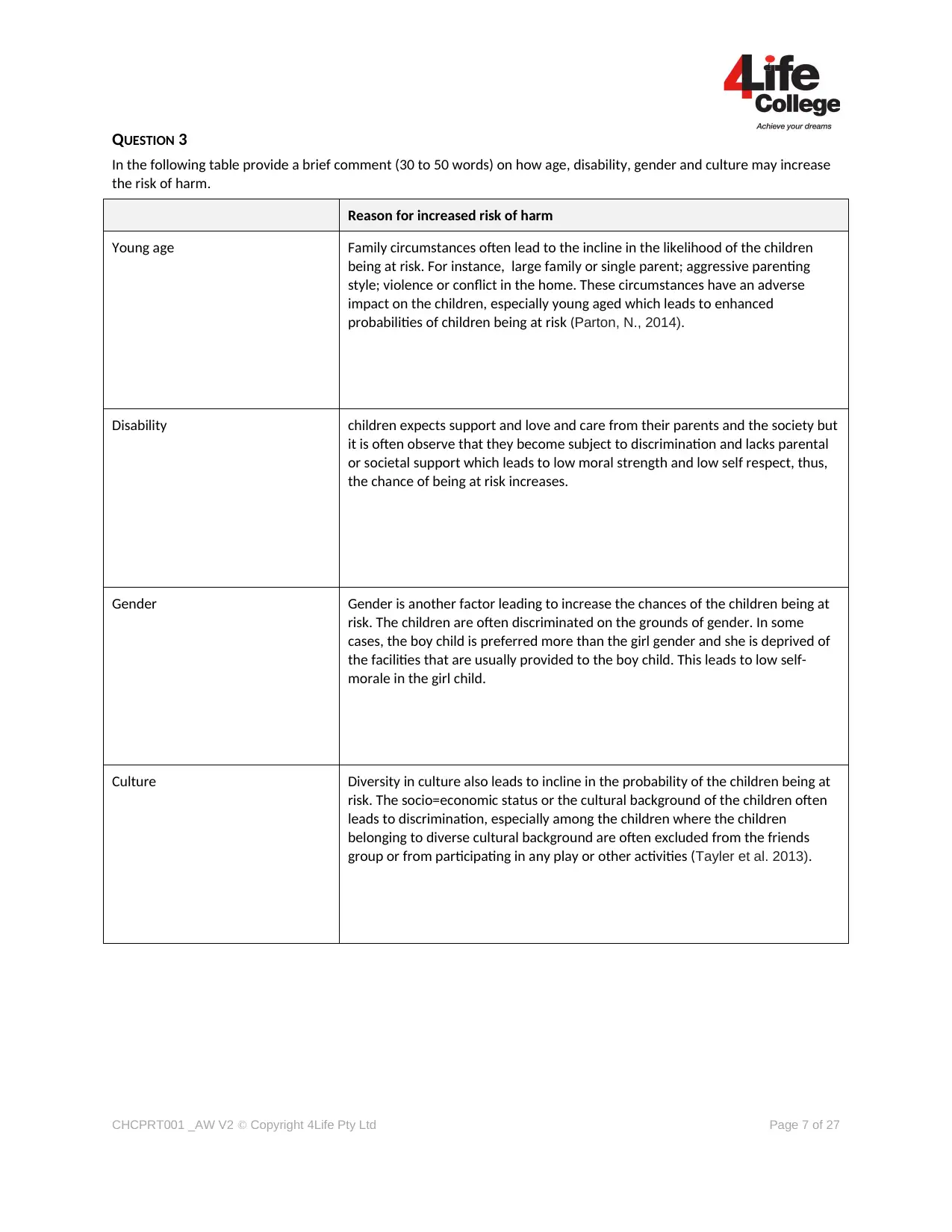
QUESTION 3
In the following table provide a brief comment (30 to 50 words) on how age, disability, gender and culture may increase
the risk of harm.
Reason for increased risk of harm
Young age Family circumstances often lead to the incline in the likelihood of the children
being at risk. For instance, large family or single parent; aggressive parenting
style; violence or conflict in the home. These circumstances have an adverse
impact on the children, especially young aged which leads to enhanced
probabilities of children being at risk (Parton, N., 2014).
Disability children expects support and love and care from their parents and the society but
it is often observe that they become subject to discrimination and lacks parental
or societal support which leads to low moral strength and low self respect, thus,
the chance of being at risk increases.
Gender Gender is another factor leading to increase the chances of the children being at
risk. The children are often discriminated on the grounds of gender. In some
cases, the boy child is preferred more than the girl gender and she is deprived of
the facilities that are usually provided to the boy child. This leads to low self-
morale in the girl child.
Culture Diversity in culture also leads to incline in the probability of the children being at
risk. The socio=economic status or the cultural background of the children often
leads to discrimination, especially among the children where the children
belonging to diverse cultural background are often excluded from the friends
group or from participating in any play or other activities (Tayler et al. 2013).
CHCPRT001 _AW V2 Copyright 4Life Pty Ltd Page 7 of 27
In the following table provide a brief comment (30 to 50 words) on how age, disability, gender and culture may increase
the risk of harm.
Reason for increased risk of harm
Young age Family circumstances often lead to the incline in the likelihood of the children
being at risk. For instance, large family or single parent; aggressive parenting
style; violence or conflict in the home. These circumstances have an adverse
impact on the children, especially young aged which leads to enhanced
probabilities of children being at risk (Parton, N., 2014).
Disability children expects support and love and care from their parents and the society but
it is often observe that they become subject to discrimination and lacks parental
or societal support which leads to low moral strength and low self respect, thus,
the chance of being at risk increases.
Gender Gender is another factor leading to increase the chances of the children being at
risk. The children are often discriminated on the grounds of gender. In some
cases, the boy child is preferred more than the girl gender and she is deprived of
the facilities that are usually provided to the boy child. This leads to low self-
morale in the girl child.
Culture Diversity in culture also leads to incline in the probability of the children being at
risk. The socio=economic status or the cultural background of the children often
leads to discrimination, especially among the children where the children
belonging to diverse cultural background are often excluded from the friends
group or from participating in any play or other activities (Tayler et al. 2013).
CHCPRT001 _AW V2 Copyright 4Life Pty Ltd Page 7 of 27
Paraphrase This Document
Need a fresh take? Get an instant paraphrase of this document with our AI Paraphraser
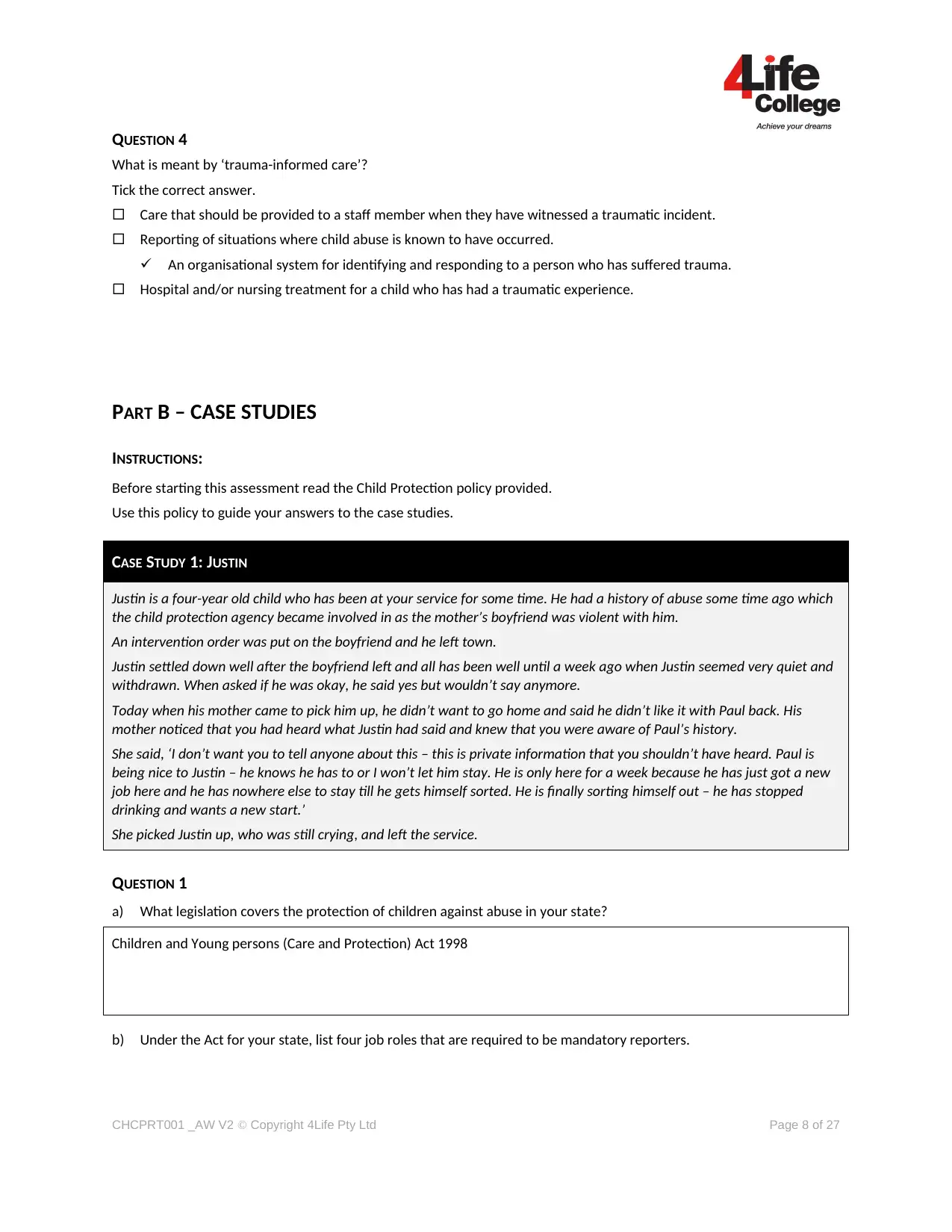
QUESTION 4
What is meant by ‘trauma-informed care’?
Tick the correct answer.
¨ Care that should be provided to a staff member when they have witnessed a traumatic incident.
¨ Reporting of situations where child abuse is known to have occurred.
An organisational system for identifying and responding to a person who has suffered trauma.
¨ Hospital and/or nursing treatment for a child who has had a traumatic experience.
PART B – CASE STUDIES
INSTRUCTIONS:
Before starting this assessment read the Child Protection policy provided.
Use this policy to guide your answers to the case studies.
CASE STUDY 1: JUSTIN
Justin is a four-year old child who has been at your service for some time. He had a history of abuse some time ago which
the child protection agency became involved in as the mother’s boyfriend was violent with him.
An intervention order was put on the boyfriend and he left town.
Justin settled down well after the boyfriend left and all has been well until a week ago when Justin seemed very quiet and
withdrawn. When asked if he was okay, he said yes but wouldn’t say anymore.
Today when his mother came to pick him up, he didn’t want to go home and said he didn’t like it with Paul back. His
mother noticed that you had heard what Justin had said and knew that you were aware of Paul’s history.
She said, ‘I don’t want you to tell anyone about this – this is private information that you shouldn’t have heard. Paul is
being nice to Justin – he knows he has to or I won’t let him stay. He is only here for a week because he has just got a new
job here and he has nowhere else to stay till he gets himself sorted. He is finally sorting himself out – he has stopped
drinking and wants a new start.’
She picked Justin up, who was still crying, and left the service.
QUESTION 1
a) What legislation covers the protection of children against abuse in your state?
Children and Young persons (Care and Protection) Act 1998
b) Under the Act for your state, list four job roles that are required to be mandatory reporters.
CHCPRT001 _AW V2 Copyright 4Life Pty Ltd Page 8 of 27
What is meant by ‘trauma-informed care’?
Tick the correct answer.
¨ Care that should be provided to a staff member when they have witnessed a traumatic incident.
¨ Reporting of situations where child abuse is known to have occurred.
An organisational system for identifying and responding to a person who has suffered trauma.
¨ Hospital and/or nursing treatment for a child who has had a traumatic experience.
PART B – CASE STUDIES
INSTRUCTIONS:
Before starting this assessment read the Child Protection policy provided.
Use this policy to guide your answers to the case studies.
CASE STUDY 1: JUSTIN
Justin is a four-year old child who has been at your service for some time. He had a history of abuse some time ago which
the child protection agency became involved in as the mother’s boyfriend was violent with him.
An intervention order was put on the boyfriend and he left town.
Justin settled down well after the boyfriend left and all has been well until a week ago when Justin seemed very quiet and
withdrawn. When asked if he was okay, he said yes but wouldn’t say anymore.
Today when his mother came to pick him up, he didn’t want to go home and said he didn’t like it with Paul back. His
mother noticed that you had heard what Justin had said and knew that you were aware of Paul’s history.
She said, ‘I don’t want you to tell anyone about this – this is private information that you shouldn’t have heard. Paul is
being nice to Justin – he knows he has to or I won’t let him stay. He is only here for a week because he has just got a new
job here and he has nowhere else to stay till he gets himself sorted. He is finally sorting himself out – he has stopped
drinking and wants a new start.’
She picked Justin up, who was still crying, and left the service.
QUESTION 1
a) What legislation covers the protection of children against abuse in your state?
Children and Young persons (Care and Protection) Act 1998
b) Under the Act for your state, list four job roles that are required to be mandatory reporters.
CHCPRT001 _AW V2 Copyright 4Life Pty Ltd Page 8 of 27
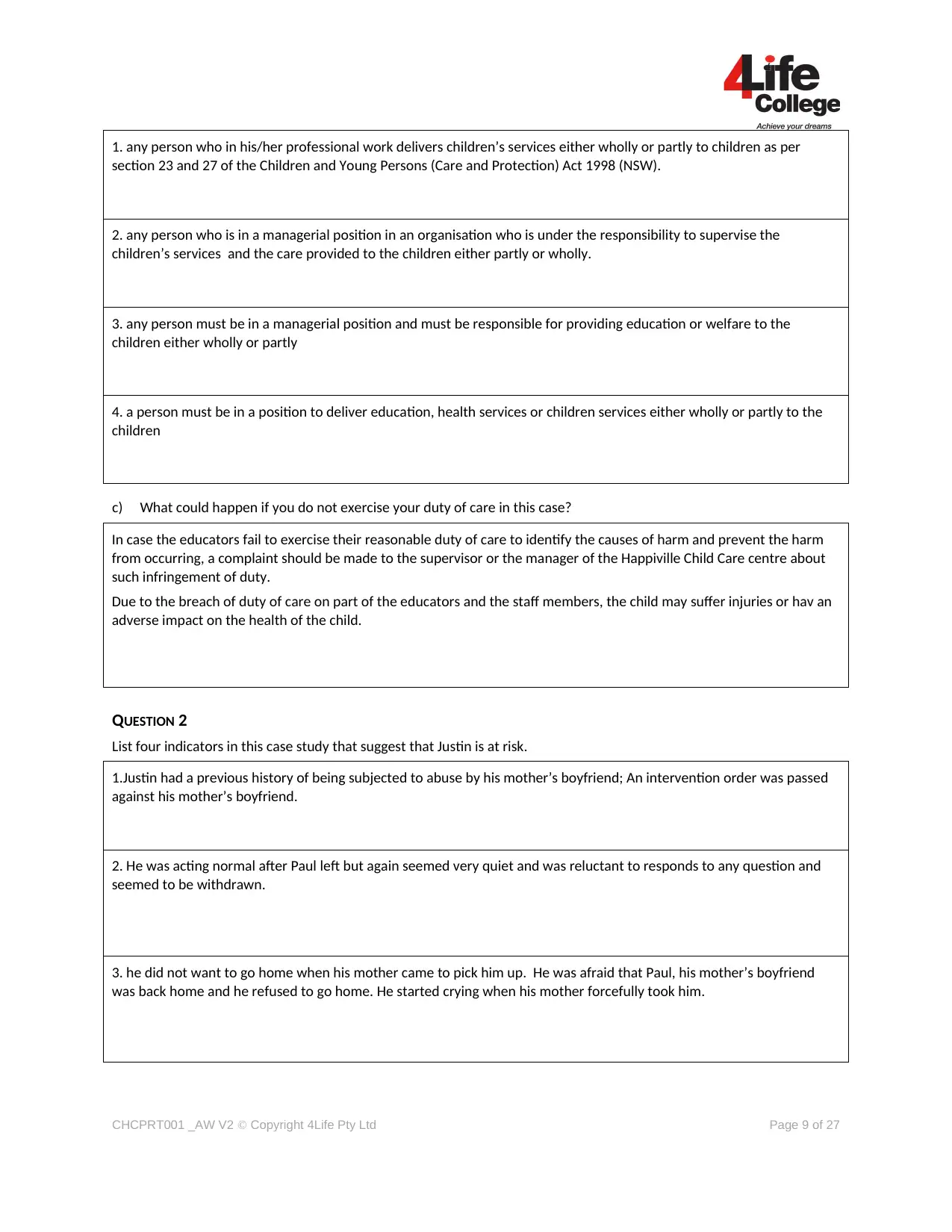
1. any person who in his/her professional work delivers children’s services either wholly or partly to children as per
section 23 and 27 of the Children and Young Persons (Care and Protection) Act 1998 (NSW).
2. any person who is in a managerial position in an organisation who is under the responsibility to supervise the
children’s services and the care provided to the children either partly or wholly.
3. any person must be in a managerial position and must be responsible for providing education or welfare to the
children either wholly or partly
4. a person must be in a position to deliver education, health services or children services either wholly or partly to the
children
c) What could happen if you do not exercise your duty of care in this case?
In case the educators fail to exercise their reasonable duty of care to identify the causes of harm and prevent the harm
from occurring, a complaint should be made to the supervisor or the manager of the Happiville Child Care centre about
such infringement of duty.
Due to the breach of duty of care on part of the educators and the staff members, the child may suffer injuries or hav an
adverse impact on the health of the child.
QUESTION 2
List four indicators in this case study that suggest that Justin is at risk.
1.Justin had a previous history of being subjected to abuse by his mother’s boyfriend; An intervention order was passed
against his mother’s boyfriend.
2. He was acting normal after Paul left but again seemed very quiet and was reluctant to responds to any question and
seemed to be withdrawn.
3. he did not want to go home when his mother came to pick him up. He was afraid that Paul, his mother’s boyfriend
was back home and he refused to go home. He started crying when his mother forcefully took him.
CHCPRT001 _AW V2 Copyright 4Life Pty Ltd Page 9 of 27
section 23 and 27 of the Children and Young Persons (Care and Protection) Act 1998 (NSW).
2. any person who is in a managerial position in an organisation who is under the responsibility to supervise the
children’s services and the care provided to the children either partly or wholly.
3. any person must be in a managerial position and must be responsible for providing education or welfare to the
children either wholly or partly
4. a person must be in a position to deliver education, health services or children services either wholly or partly to the
children
c) What could happen if you do not exercise your duty of care in this case?
In case the educators fail to exercise their reasonable duty of care to identify the causes of harm and prevent the harm
from occurring, a complaint should be made to the supervisor or the manager of the Happiville Child Care centre about
such infringement of duty.
Due to the breach of duty of care on part of the educators and the staff members, the child may suffer injuries or hav an
adverse impact on the health of the child.
QUESTION 2
List four indicators in this case study that suggest that Justin is at risk.
1.Justin had a previous history of being subjected to abuse by his mother’s boyfriend; An intervention order was passed
against his mother’s boyfriend.
2. He was acting normal after Paul left but again seemed very quiet and was reluctant to responds to any question and
seemed to be withdrawn.
3. he did not want to go home when his mother came to pick him up. He was afraid that Paul, his mother’s boyfriend
was back home and he refused to go home. He started crying when his mother forcefully took him.
CHCPRT001 _AW V2 Copyright 4Life Pty Ltd Page 9 of 27
⊘ This is a preview!⊘
Do you want full access?
Subscribe today to unlock all pages.

Trusted by 1+ million students worldwide
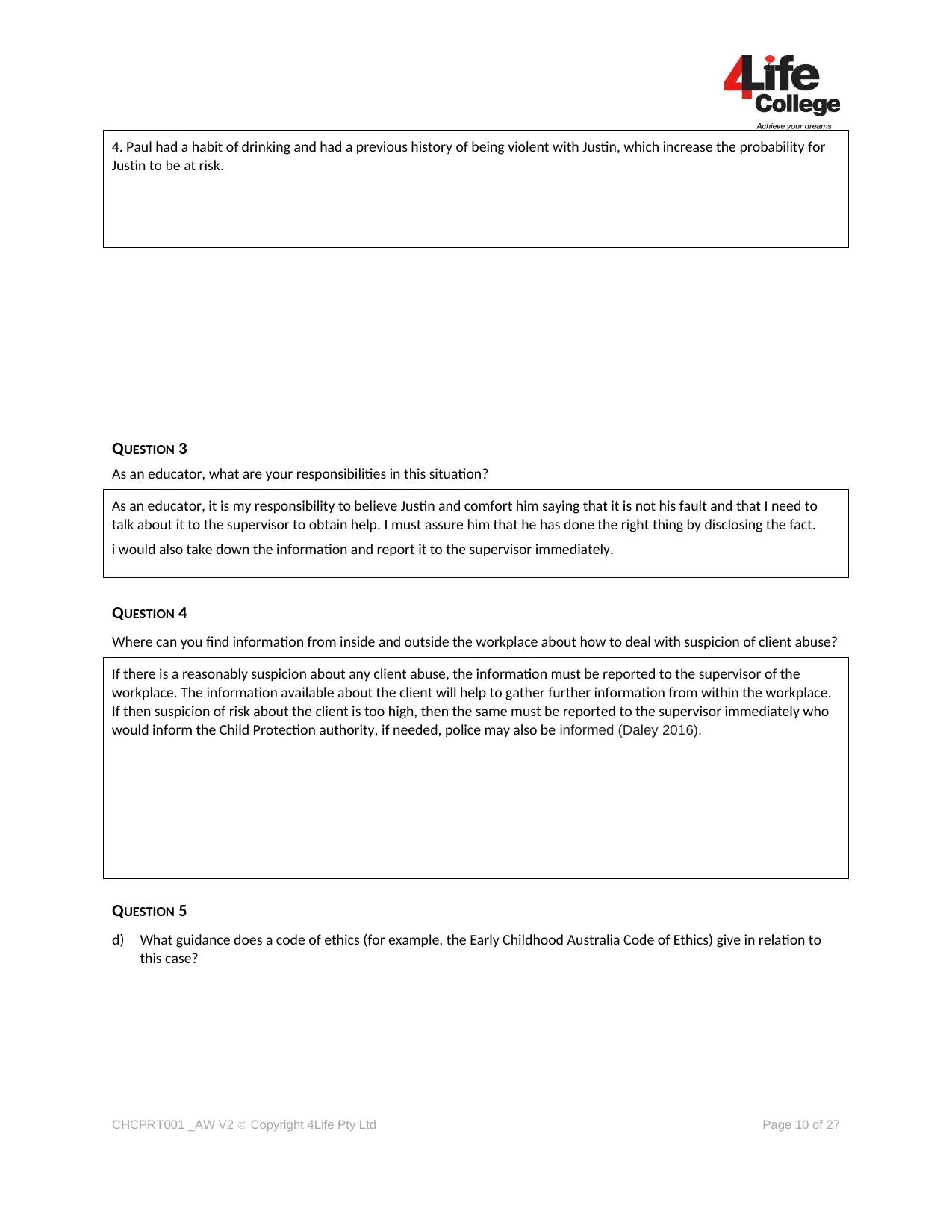
4. Paul had a habit of drinking and had a previous history of being violent with Justin, which increase the probability for
Justin to be at risk.
QUESTION 3
As an educator, what are your responsibilities in this situation?
As an educator, it is my responsibility to believe Justin and comfort him saying that it is not his fault and that I need to
talk about it to the supervisor to obtain help. I must assure him that he has done the right thing by disclosing the fact.
i would also take down the information and report it to the supervisor immediately.
QUESTION 4
Where can you find information from inside and outside the workplace about how to deal with suspicion of client abuse?
If there is a reasonably suspicion about any client abuse, the information must be reported to the supervisor of the
workplace. The information available about the client will help to gather further information from within the workplace.
If then suspicion of risk about the client is too high, then the same must be reported to the supervisor immediately who
would inform the Child Protection authority, if needed, police may also be informed (Daley 2016).
QUESTION 5
d) What guidance does a code of ethics (for example, the Early Childhood Australia Code of Ethics) give in relation to
this case?
CHCPRT001 _AW V2 Copyright 4Life Pty Ltd Page 10 of 27
Justin to be at risk.
QUESTION 3
As an educator, what are your responsibilities in this situation?
As an educator, it is my responsibility to believe Justin and comfort him saying that it is not his fault and that I need to
talk about it to the supervisor to obtain help. I must assure him that he has done the right thing by disclosing the fact.
i would also take down the information and report it to the supervisor immediately.
QUESTION 4
Where can you find information from inside and outside the workplace about how to deal with suspicion of client abuse?
If there is a reasonably suspicion about any client abuse, the information must be reported to the supervisor of the
workplace. The information available about the client will help to gather further information from within the workplace.
If then suspicion of risk about the client is too high, then the same must be reported to the supervisor immediately who
would inform the Child Protection authority, if needed, police may also be informed (Daley 2016).
QUESTION 5
d) What guidance does a code of ethics (for example, the Early Childhood Australia Code of Ethics) give in relation to
this case?
CHCPRT001 _AW V2 Copyright 4Life Pty Ltd Page 10 of 27
Paraphrase This Document
Need a fresh take? Get an instant paraphrase of this document with our AI Paraphraser
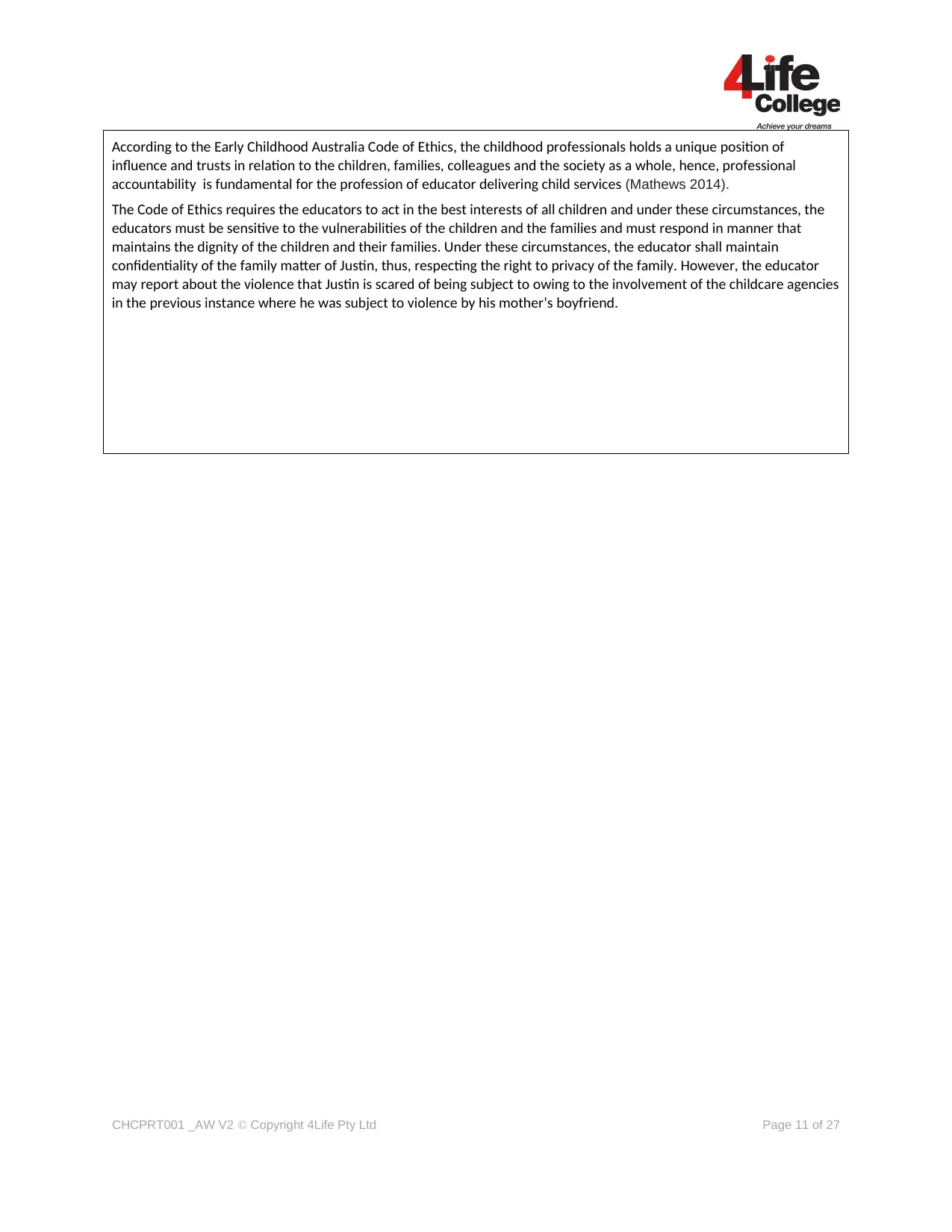
According to the Early Childhood Australia Code of Ethics, the childhood professionals holds a unique position of
influence and trusts in relation to the children, families, colleagues and the society as a whole, hence, professional
accountability is fundamental for the profession of educator delivering child services (Mathews 2014).
The Code of Ethics requires the educators to act in the best interests of all children and under these circumstances, the
educators must be sensitive to the vulnerabilities of the children and the families and must respond in manner that
maintains the dignity of the children and their families. Under these circumstances, the educator shall maintain
confidentiality of the family matter of Justin, thus, respecting the right to privacy of the family. However, the educator
may report about the violence that Justin is scared of being subject to owing to the involvement of the childcare agencies
in the previous instance where he was subject to violence by his mother’s boyfriend.
CHCPRT001 _AW V2 Copyright 4Life Pty Ltd Page 11 of 27
influence and trusts in relation to the children, families, colleagues and the society as a whole, hence, professional
accountability is fundamental for the profession of educator delivering child services (Mathews 2014).
The Code of Ethics requires the educators to act in the best interests of all children and under these circumstances, the
educators must be sensitive to the vulnerabilities of the children and the families and must respond in manner that
maintains the dignity of the children and their families. Under these circumstances, the educator shall maintain
confidentiality of the family matter of Justin, thus, respecting the right to privacy of the family. However, the educator
may report about the violence that Justin is scared of being subject to owing to the involvement of the childcare agencies
in the previous instance where he was subject to violence by his mother’s boyfriend.
CHCPRT001 _AW V2 Copyright 4Life Pty Ltd Page 11 of 27
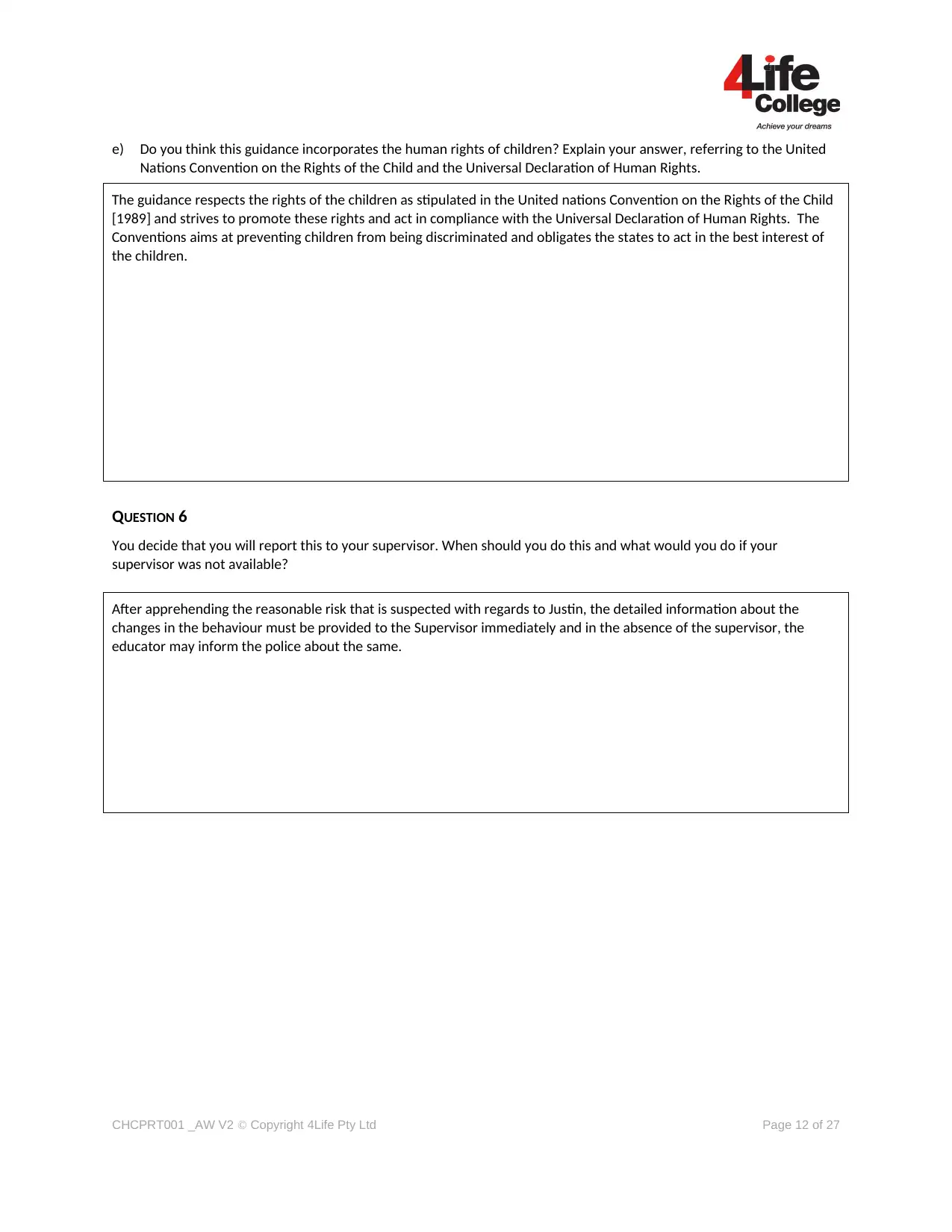
e) Do you think this guidance incorporates the human rights of children? Explain your answer, referring to the United
Nations Convention on the Rights of the Child and the Universal Declaration of Human Rights.
The guidance respects the rights of the children as stipulated in the United nations Convention on the Rights of the Child
[1989] and strives to promote these rights and act in compliance with the Universal Declaration of Human Rights. The
Conventions aims at preventing children from being discriminated and obligates the states to act in the best interest of
the children.
QUESTION 6
You decide that you will report this to your supervisor. When should you do this and what would you do if your
supervisor was not available?
After apprehending the reasonable risk that is suspected with regards to Justin, the detailed information about the
changes in the behaviour must be provided to the Supervisor immediately and in the absence of the supervisor, the
educator may inform the police about the same.
CHCPRT001 _AW V2 Copyright 4Life Pty Ltd Page 12 of 27
Nations Convention on the Rights of the Child and the Universal Declaration of Human Rights.
The guidance respects the rights of the children as stipulated in the United nations Convention on the Rights of the Child
[1989] and strives to promote these rights and act in compliance with the Universal Declaration of Human Rights. The
Conventions aims at preventing children from being discriminated and obligates the states to act in the best interest of
the children.
QUESTION 6
You decide that you will report this to your supervisor. When should you do this and what would you do if your
supervisor was not available?
After apprehending the reasonable risk that is suspected with regards to Justin, the detailed information about the
changes in the behaviour must be provided to the Supervisor immediately and in the absence of the supervisor, the
educator may inform the police about the same.
CHCPRT001 _AW V2 Copyright 4Life Pty Ltd Page 12 of 27
⊘ This is a preview!⊘
Do you want full access?
Subscribe today to unlock all pages.

Trusted by 1+ million students worldwide
1 out of 26
Related Documents
Your All-in-One AI-Powered Toolkit for Academic Success.
+13062052269
info@desklib.com
Available 24*7 on WhatsApp / Email
![[object Object]](/_next/static/media/star-bottom.7253800d.svg)
Unlock your academic potential
Copyright © 2020–2025 A2Z Services. All Rights Reserved. Developed and managed by ZUCOL.




